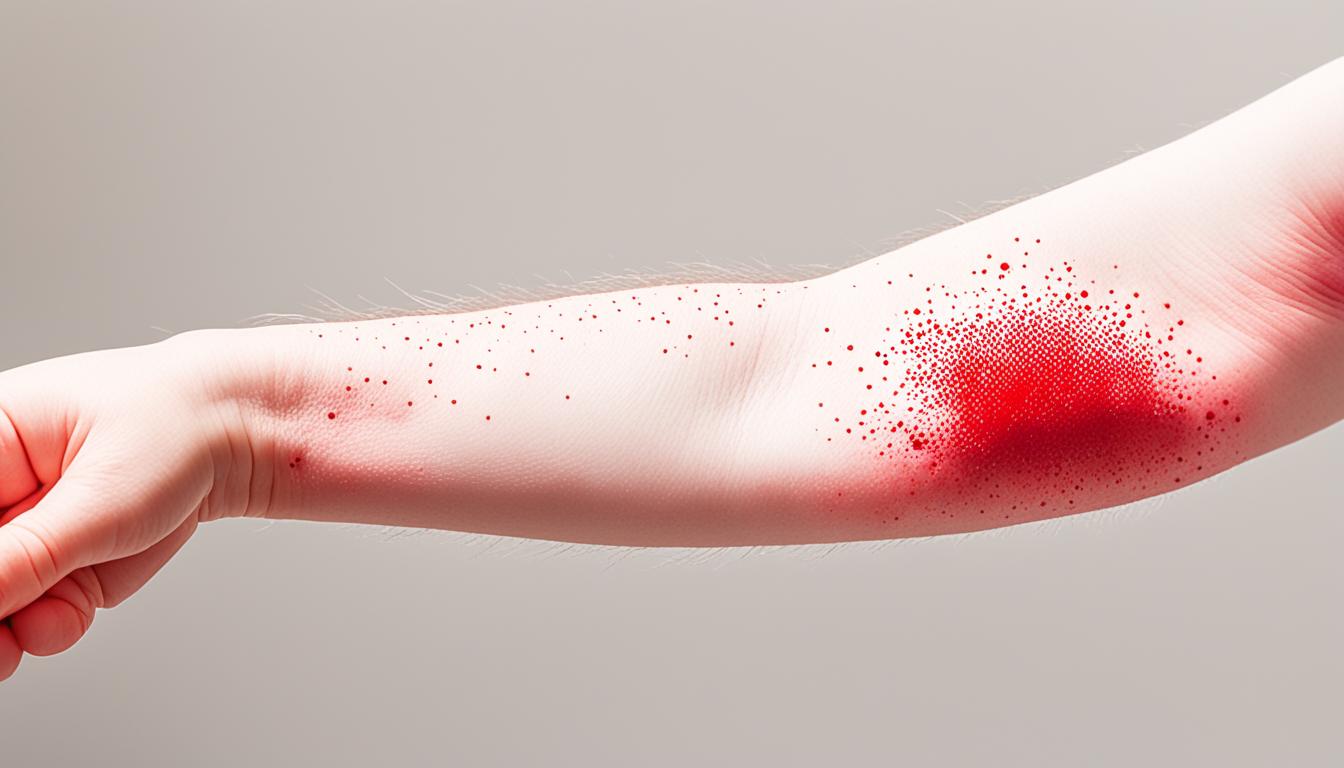Scarlet fever is a very contagious illness that mainly affects kids. It shows up as a pink or red rash, looking a lot like sunburn. This rash feels rough, like sandpaper, and often starts on the chest.
It then spreads over the body, avoiding the face. Along with the rash, someone with scarlet fever might have a sore throat and feel sick. They could also have a fever, headache, and find it hard to swallow.
Scarlet fever comes from a bacterium, Streptococcus pyogenes, also known for causing strep throat. It travels through the air when someone coughs or sneezes. You can also catch it by touching things the bacteria is on.
Using penicillin or other antibiotics early can prevent serious issues like pneumonia. In recent times, some scientists have looked into using stem cells to treat scarlet fever. But, this method still needs more study.
Key Takeaways:
- Scarlet fever is a highly contagious illness primarily affecting children.
- It is characterized by a distinctive pink-red or discolored rash.
- Common symptoms include sore throat, fever, headache, and difficulty swallowing.
- Scarlet fever is caused by Streptococcus pyogenes, the same bacteria that causes strep throat.
- Prompt treatment with antibiotics is essential to prevent complications.
- Stem cell therapy is being explored as a potential treatment option for scarlet fever.
- More research is needed to establish the safety and efficacy of stem cell therapy for scarlet fever.
Causes and Diagnosis of Scarlet Fever
Scarlet fever spreads easily. It comes from Streptococcus pyogenes, the same bacteria that causes strep throat. This tiny germ can lead to more than just scarlet fever. It’s also behind impetigo and other infections.
You get scarlet fever from infected people’s coughs or sneezes. It can also be on things people touch or if you touch someone with a strep skin infection.
The rash is a key sign of scarlet fever. It’s red and feels like sandpaper. The illness comes with a sore throat and fever too. Doctors often take a throat swab to see if the strep germs are there. Sometimes they do a blood test too.
Spotting scarlet fever early is key. Doctors prescribe antibiotics, like penicillin. These drugs fight the infection and lower the chance of complications. Remember, always finish the full course of antibiotics your doctor gives you.
Treating scarlet fever fast also stops it from spreading. It’s a great way to help you recover faster and avoid serious health issues.
Possible Complications
- Pneumonia
- Otitis media (ear infection)
- Sinusitis (sinus infection)
- Meningitis (infection of the membranes surrounding the brain and spinal cord)
- Rheumatic fever (an inflammatory disease that can affect the heart, joints, skin, and brain)
- Post-streptococcal glomerulonephritis (a kidney condition)
Complications from scarlet fever are rare with quick care. If you or your child have symptoms, see a doctor. This is especially true if you’ve been near someone with scarlet fever or streptococcal infections.
Symptoms and Treatment of Scarlet Fever
Scarlet fever, also called scarlatina, shows symptoms that tell us someone might have it. A big sign is a red, sore throat and fever. Soon after getting infected, usually in 1 to 4 days, a rash appears. This rash starts as red blotches and becomes a pink-red rash, looking like sunburn. It’s not on the face and feels rough, like sandpaper.
Besides the rash and sore throat, people with this illness might find it hard to swallow. They could also get headaches, feel itchy, or feel like throwing up. Their neck glands might swell up. Remember, how bad these symptoms are can change for each person from mild to harsh.
Scarlet fever can go away on its own in about a week. But, it’s better to take antibiotics to get well faster and lower the chances of problems. The usual medicine is penicillin, which kills the bacteria causing the illness. If someone can’t have penicillin, they might get other antibiotics. Whoever takes antibiotics must finish all the medicine to stop the illness from coming back and avoid more problems.
Managing symptoms at home can also help. This includes using acetaminophen for fever and pain. Also, calamine lotion can help with itchiness. Don’t forget to drink enough water or fluids.
Stem Cell Therapy for Scarlet Fever: An Emerging Treatment Option
Right now, antibiotics are the top way to treat scarlet fever. But people are getting more interested in using stem cell therapy alongside this. Stem cell therapy uses cells that can change into many types of cells. This means they can help repair and make new tissues. In scarlet fever, the goal is to boost the body’s immune response and speed up healing.
Studies are just starting in this area, but some have seen good results in tests with animals and people. Stem cell therapy for scarlet fever offers a focused and customized way to treat it. In places like Thailand, medical innovation is growing, leading to new treatment options like stem cell therapy for scarlet fever.
Yet, we need more studies and tests to be sure stem cell therapy is very safe and works well for scarlet fever. Even though the initial results look good, we must wait for more proof. This way, stem cell therapy could be widely used to treat scarlet fever. Many researchers and doctors are doing their best to learn all they can about how stem cell therapy might help with this sickness.

